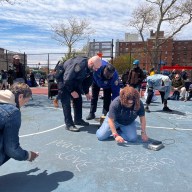By Dustin Brown
The intersection of Myrtle and Cooper avenues in Glendale is an awkward muddle where too many streets pass through too small a space.
Myrtle, a popular shopping strip, follows a straight east-west path which Cooper crosses at a slight angle, creating a wide interchange between two of the neighborhood’s most heavily traveled streets. From the sky it looks like a flattened “X,” but from the ground it creates a complicated confluence of traffic aggravated by the adjacent crossings of 70th and 71st streets.
It is also dangerous. In the past eight months, two pedestrians have died at Myrtle Avenue and 70th Street, about 100 feet west of where Myrtle and Cooper meet. A 12-year-old girl was killed after being struck Nov. 10 and a 68-year-old man died after a car hit him March 26.
Lori Phelan, a Myrtle Avenue resident who lives at the intersection with 70th Street, has fought for the past year to convince the city Department of Transportation to improve the safety conditions in front of her home. One traffic light, numerous signs and some timing adjustments later, she is still not satisfied.
“You don’t know if someone’s going to get hit or if there’s going to be an accident or what,” Phelan said recently in a phone interview. “I’m frightened.”
Where Myrtle and Cooper meet they carve out a small sliver of land dedicated to the Glendale Veterans Triangle, the base of which is the short segment of 70th Street running between the two avenues.
Phelan and her children have collected about 600 signatures on a petition calling for the city DOT to close off the stretch of 70th Street that connects Myrtle and Cooper, which would set aside additional land that could be used to extend the memorial or create an outdoor seating area for a nearby restaurant. It would also cut off one of the primary paths feeding into the complicated intersection, which she hopes would render it safer for pedestrians.
Gary Giordano, the district manager for Community Board 5, has asked the DOT to evaluate the feasibility of closing off the roadway as a means of simplifying the traffic patterns.
“It’s a very hard place, it’s a very difficult intersection,” Giordano said.
And difficult intersections rarely have easy solutions.
The area has already been the focus of aggressive improvement efforts on the part of the DOT, which installed a traffic light at the intersection of Cooper Avenue and 70th Street in late November. But when the new signal initially clogged the roadway, the timing was adjusted to give the westbound traffic on both Myrtle and Cooper a longer green light than eastbound vehicles crossing 70th Street.
“The signal is actually clearing out very well,” said Joseph Cannisi, the Queens borough commissioner for the DOT, who paid a visit to the site only last week.
But the change is also counterintuitive for the drivers and pedestrians who assume that whenever a traffic light is red on one side, the same holds true on the other.
Although the DOT has installed signs instructing drivers to wait for the green light and pedestrians to wait for the walk signal, Phelan said she has frequently witnessed close calls.
“I see many seniors almost nearly killed because they don’t know the other side is green,” Phelan said.
Cannisi said he noticed during his visit that the walk signal is too brief, and he has already asked the DOT’s signal division to examine whether more time can be added to it.
But the idea of closing off the triangle may simply compound the problems that are already there, Cannisi said.
“Closing that little block is going to have a domino effect to do it in a safe manner,” he noted. “I’m not really a fan of it.”
The pedestrian who died in March was hit by a vehicle that had been traveling southbound on 70th Street and turned left onto Myrtle. The driver faced a green light and the pedestrian had a walk signal, but the pedestrian had the right-of-way and the driver failed to yield.
Such incidents would only increase if 70th Street were closed at the triangle, Cannisi said, because all traffic would be forced to turn at the intersection.
“You will increase the conflict with pedestrians in the crosswalk,” Cannisi said.
The DOT would likely reverse the direction of 70th Street from southbound to northbound traffic if it closed the triangle, Cannisi said, and then the directions of adjacent streets would also have to be altered to accommodate the change, he said.
Closing 70th Street would also prompt some cars to make wide, awkward turns from Cooper to Myrtle and vice-versa, Cannisi said.
If the DOT concludes it would be possible to close off 70th Street, the issue would be tossed back to the community board, which would hold public hearings and issue a recommendation, Giordano said. But the final decision will rest with the DOT.
Until then, Phelan will continue to fret.
“I feel more safe crossing Queens Boulevard than I do right in front of my own home,” she said.
Reach reporter Dustin Brown by e-mail at Timesledger@aol.com or call 229-0300, Ext. 154.































